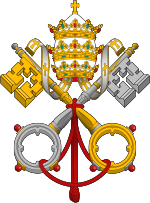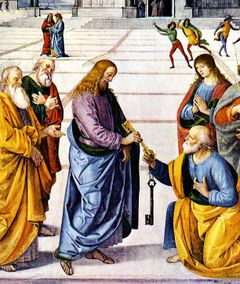Pope Leo IX
| Saint Leo IX | |
|---|---|
 |
|
| Papacy began | February 12, 1049 |
| Papacy ended | April 19, 1054 |
| Predecessor | Damasus II |
| Successor | Victor II |
| Personal details | |
| Birth name | Bruno von Eguisheim-Dagsburg |
| Born | June 21, 1002 Eguisheim, Alsace, Duchy of Swabia, Holy Roman Empire |
| Died | April 19, 1054 (aged 51) Rome, Papal States, Holy Roman Empire |
| Sainthood | |
| Feast day | April 19 |
| Other Popes named Leo | |
| Papal styles of Pope Leo IX |
|
|---|---|
 |
|
| Reference style | His Holiness |
| Spoken style | Your Holiness |
| Religious style | Holy Father |
| Posthumous style | Saint |
Pope Saint Leo IX (June 21, 1002 – April 19, 1054), born Bruno of Eguisheim-Dagsburg (German Bruno von Egisheim-Dagsburg), was Pope from February 12, 1049 to his death. He is regarded as a saint by the Roman Catholic Church, with the feast day of April 19. Leo IX is widely considered the most historically significant German Pope of the Middle Ages.
Contents |
Biography
Leo IX was a native of Eguisheim, Upper Alsace, now in France, but then firmly German. The family to which he belonged was of noble rank, and his father, Count Hugo, was a relative of Emperor Conrad II (1024–1039). He was educated at Toul, where he successively became canon and, in 1026, bishop. In the latter capacity he rendered important political services to his relative Conrad II, and afterwards to Emperor Henry III (1039–1056). He became widely known as an earnest and reforming ecclesiastic by the zeal he showed in spreading the rule of the order of Cluny.
On the death of Pope Damasus II (1048), Bruno was selected as his successor by an assembly at Worms in December 1048. Both the Emperor and the Roman delegates concurred. However, Bruno apparently favored a canonical election and stipulated as a condition of his acceptance that he should first proceed to Rome and be freely elected by the voice of clergy and people of Rome. Setting out shortly after Christmas, he met with abbot Hugh of Cluny at Besançon, where he was joined by the young monk Hildebrand, who afterwards became Pope Gregory VII (1073–85); arriving in pilgrim garb at Rome in the following February, he was received with much cordiality, and at his consecration assumed the name of Leo IX.
Leo IX favored traditional morality in his reformation of the Catholic Church. One of his first public acts was to hold the well-known Easter synod of 1049, at which celibacy of the clergy (down to the rank of subdeacon) was required anew. Also, the Easter synod was where the Pope at least succeeded in making clear his own convictions against every kind of simony. The greater part of the year that followed was occupied in one of those progresses through Italy, Germany and France which form a marked feature in Leo IX's pontificate. After presiding over a synod at Pavia, he joined Henry III in Saxony, and accompanied him to Cologne and Aachen; to Reims he also summoned a meeting of the higher clergy, by which several important reforming decrees were passed. At Mainz also he held a council, at which the Italian and French as well as the German clergy were represented, and ambassadors of the Greek emperor were present; here too simony and the marriage of the clergy were the principal matters dealt with.
After his return to Rome he held (April 29, 1050) another Easter synod, which was occupied largely with the controversy about the teachings of Berengar of Tours; in the same year he presided over provincial synods at Salerno, Siponto and Vercelli, and in September revisited his native Germany, returning to Rome in time for a third Easter synod, at which the question of the reordination of those who had been ordained by simonists was considered.
In 1052 he joined the Emperor at Pressburg, and vainly sought to secure the submission of the Hungarians; and at Regensburg, Bamberg and Worms the papal presence was marked by various ecclesiastical solemnities.

After a fourth Easter synod in 1053 Leo IX set out against the Normans in the south with an army of Italians and German volunteers, but his forces suffered total defeat at the Battle of Civitate on June 15, 1053; on going out, however, from the city to meet the victorious enemy he was received with every token of submission, pleas for forgiveness and oaths of fidelity and homage. From June 1053 to March 1054 the Pope was nevertheless detained at Benevento in honourable captivity; he did not long survive his return to Rome, where he died on April 19, 1054.
Leo IX sent a letter to Michael Cærularius, Patriarch of Constantinople, in 1054, that cited a large portion of the Donation of Constantine believing it genuine.[1] The official status of this letter is acknowledged in the 1913 Catholic Encyclopedia, Volume 5, entry on Donation of Constantine, page 120:
- "The first pope who used it in an official act and relied upon it, was Leo IX; in a letter of 1054 to Michael Cærularius, Patriarch of Constantinople, he cites the "Donatio" to show that the Holy See possessed both an earthly and a heavenly imperium, the royal priesthood."
Leo IX assured the Patriarch that the donation was completely genuine, not a fable or old wives tale, so only the apostolic successor to Peter possessed that primacy and was the rightful head of all the Church. The Patriarch rejected the claims of papal primacy, and subsequently the Catholic Church was split in two in the Great East-West Schism of 1054.
Before his death, Leo IX had sent a legatine mission, under Cardinal Humbert of Silva Candida, to Constantinople, to negotiate with Patriarch Michael I Cerularius (1043–1059) in response to his actions concerning the church in Southern Italy. Humbert quickly disposed of negotiations by delivering a bull excommunicating the Patriarch. This act, though legally invalid due to the Pope's death at the time, was answered by the Patriarch's own bull of excommunication against the Humbert and his associates and is popularly considered the official split between the Eastern and Western Churches in what is now called the Schism of 1054.
References
- ↑ Migne's Patrologia Latina, Vol. 143 (cxliii), Col. 744-769. Also Mansi, Sacrorum Conciliorum Nova Amplissima Collectio, Vol. 19 (xix) Col. 635-656.
 This article incorporates text from a publication now in the public domain: Chisholm, Hugh, ed (1911). Encyclopædia Britannica (Eleventh ed.). Cambridge University Press.
This article incorporates text from a publication now in the public domain: Chisholm, Hugh, ed (1911). Encyclopædia Britannica (Eleventh ed.). Cambridge University Press.
Further reading
- Migne's Patrologia Latina, Vol. 143 (cxliii), Leo IX Epistolae Et Decreta .pdf - 1.9 Mb. See Col. 744B-769D (pgs. 76-89) for Leo IX's letter.
- Mansi's, Sacrorum Conciliorum Nova Amplissima Collectio, Vol. 19 (xix) .pdf - 66 Mb. See Col. 635-656.
- Acta et scripta quae de controversiis ecclesiae Graecae et Latinae, by Dr. Cornelius Will, 1861. This book has the text of the letters relevant to the Great Schism of 1054. The Greek and Latin texts of the Schism was studied by Michele Giuseppe D'Agostino, Il Primato della Sede di Roma in Leone IX (1049–1054). Studio dei testi nella controversia greco-romana nel periodo gregoriano, Cinisello Balsamo 2008.
External links
 "Pope St. Leo IX". Catholic Encyclopedia. 1913.
"Pope St. Leo IX". Catholic Encyclopedia. 1913.
| Catholic Church titles | ||
|---|---|---|
| Preceded by Damasus II |
Pope 1049–1054 |
Succeeded by Victor II |
|
|||||||||||||||||||||||||||||||||||||||||||||
|
|||||||||||||||||||||||||||||||||||||||||

